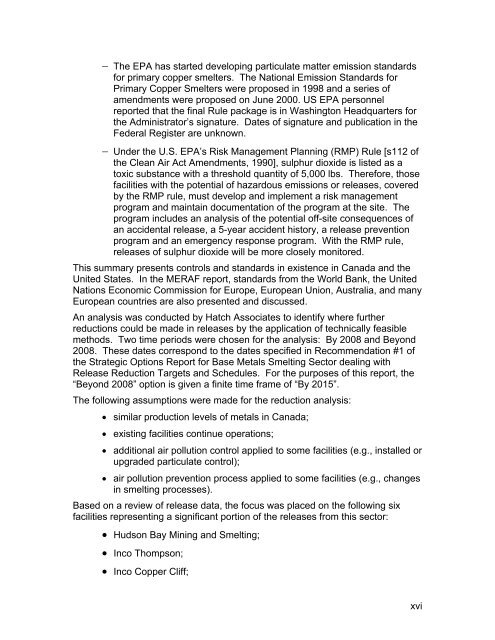(MERAF) for the Base Metals Smelting Sector - CCME
(MERAF) for the Base Metals Smelting Sector - CCME
(MERAF) for the Base Metals Smelting Sector - CCME
You also want an ePaper? Increase the reach of your titles
YUMPU automatically turns print PDFs into web optimized ePapers that Google loves.
− The EPA has started developing particulate matter emission standards<br />
<strong>for</strong> primary copper smelters. The National Emission Standards <strong>for</strong><br />
Primary Copper Smelters were proposed in 1998 and a series of<br />
amendments were proposed on June 2000. US EPA personnel<br />
reported that <strong>the</strong> final Rule package is in Washington Headquarters <strong>for</strong><br />
<strong>the</strong> Administrator’s signature. Dates of signature and publication in <strong>the</strong><br />
Federal Register are unknown.<br />
− Under <strong>the</strong> U.S. EPA’s Risk Management Planning (RMP) Rule [s112 of<br />
<strong>the</strong> Clean Air Act Amendments, 1990], sulphur dioxide is listed as a<br />
toxic substance with a threshold quantity of 5,000 lbs. There<strong>for</strong>e, those<br />
facilities with <strong>the</strong> potential of hazardous emissions or releases, covered<br />
by <strong>the</strong> RMP rule, must develop and implement a risk management<br />
program and maintain documentation of <strong>the</strong> program at <strong>the</strong> site. The<br />
program includes an analysis of <strong>the</strong> potential off-site consequences of<br />
an accidental release, a 5-year accident history, a release prevention<br />
program and an emergency response program. With <strong>the</strong> RMP rule,<br />
releases of sulphur dioxide will be more closely monitored.<br />
This summary presents controls and standards in existence in Canada and <strong>the</strong><br />
United States. In <strong>the</strong> <strong>MERAF</strong> report, standards from <strong>the</strong> World Bank, <strong>the</strong> United<br />
Nations Economic Commission <strong>for</strong> Europe, European Union, Australia, and many<br />
European countries are also presented and discussed.<br />
An analysis was conducted by Hatch Associates to identify where fur<strong>the</strong>r<br />
reductions could be made in releases by <strong>the</strong> application of technically feasible<br />
methods. Two time periods were chosen <strong>for</strong> <strong>the</strong> analysis: By 2008 and Beyond<br />
2008. These dates correspond to <strong>the</strong> dates specified in Recommendation #1 of<br />
<strong>the</strong> Strategic Options Report <strong>for</strong> <strong>Base</strong> <strong>Metals</strong> <strong>Smelting</strong> <strong>Sector</strong> dealing with<br />
Release Reduction Targets and Schedules. For <strong>the</strong> purposes of this report, <strong>the</strong><br />
“Beyond 2008” option is given a finite time frame of “By 2015”.<br />
The following assumptions were made <strong>for</strong> <strong>the</strong> reduction analysis:<br />
• similar production levels of metals in Canada;<br />
• existing facilities continue operations;<br />
• additional air pollution control applied to some facilities (e.g., installed or<br />
upgraded particulate control);<br />
• air pollution prevention process applied to some facilities (e.g., changes<br />
in smelting processes).<br />
<strong>Base</strong>d on a review of release data, <strong>the</strong> focus was placed on <strong>the</strong> following six<br />
facilities representing a significant portion of <strong>the</strong> releases from this sector:<br />
• Hudson Bay Mining and <strong>Smelting</strong>;<br />
• Inco Thompson;<br />
• Inco Copper Cliff;<br />
xvi
















